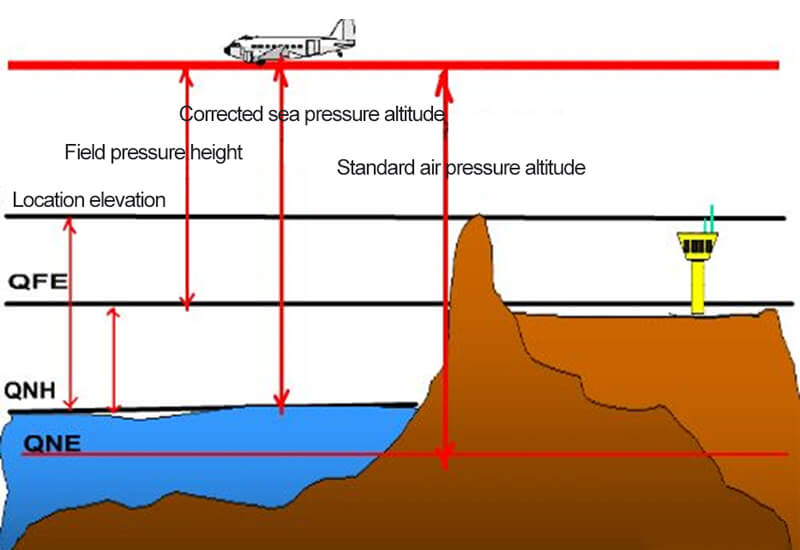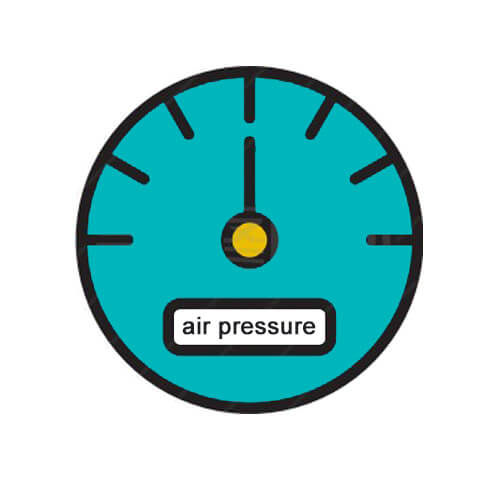Did you know? Atmospheric pressure is constantly influencing the natural phenomena around us—everything from the direction of winds, to cloud formation, and even ocean tides. Whether it’s the clear skies we enjoy or the sudden storm that catches us off guard, changes in atmospheric pressure are at the heart of it all. Understanding more about atmospheric pressure will help you better grasp how it can be measured and its impact on our daily lives. Keep reading to learn more!
How is atmospheric pressure formed?
We all know that the Earth’s surface is surrounded by a thick layer of air. This air is attracted towards the ground by Earth’s gravity, a process that creates atmospheric pressure. However, Earth’s gravity decreases with increasing altitude, so atmospheric pressure also decreases with height, forming different layers of the atmosphere. The closer you are to the surface, the denser the air molecules, and the greater the pressure.
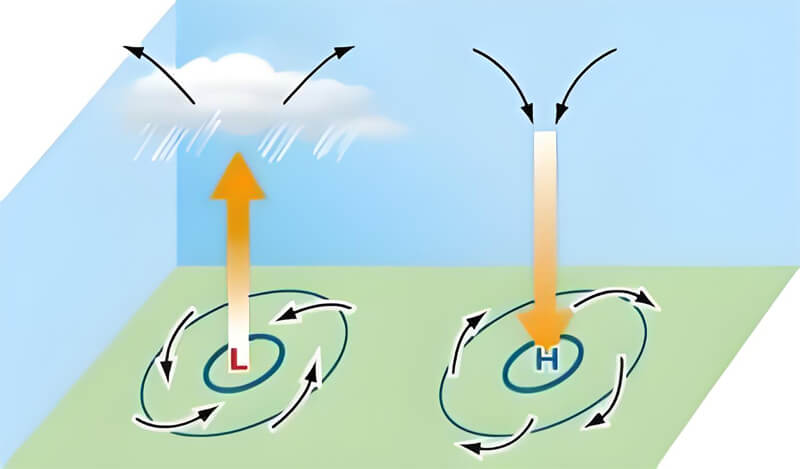
What affects atmospheric pressure?
Although Earth’s gravity divides the atmosphere into layers, this does not mean that the atmosphere is uniform and stationary. On the contrary, it is constantly in motion and undergoing changes, so atmospheric pressure is also in dynamic flux. Because in addition to the Earth’s gravity, the atmospheric pressure also changes with the Earth’s rotation, solar radiation, and terrain features.
Effects of Earth's rotation
Due to Earth’s rotation and the varying linear velocity at different latitudes, the movement of air and the distribution of atmospheric pressure on its surface are uneven. This is related to the Coriolis effect, which causes the flow of air from high-pressure areas to low-pressure areas to be deflected. This deflection results in the formation of rotating systems in the atmosphere, such as cyclones and anticyclones.
Effects of solar radiation
The Sun transfers heat to the Earth through radiation. Whether it’s direct radiation or scattered radiation, both contribute to heating the atmosphere. As the air warms up, it expands and rises, which leads to a decrease in atmospheric pressure. Because the intensity of solar radiation varies significantly across different regions and seasons, the heating of the atmosphere is uneven, causing continual changes in atmospheric pressure.
Effects of terrain features
The Earth’s surface is not flat or uniform; it consists of various landforms. These landforms absorb and release solar radiation at different rates. For example, the specific heat capacity of the ocean is relatively high, so it absorbs and releases energy more slowly, while land absorbs and releases energy more quickly. As a result, during the day, high-pressure air over the ocean moves toward the low-pressure areas on land (known as the sea breeze), while at night, high-pressure air over the land moves toward the low-pressure areas over the ocean (known as the land breeze). Additionally, features like mountains and valleys can guide or block airflows, which also contributes to changes in atmospheric pressure.
Video from @AviationTheory
How does atmospheric pressure affect weather?
High air pressure
Air molecules in an area of high air pressure move toward an area of low pressure, and the air above the high pressure area then falls. As the air falls, it shrinks in size and rises in temperature, causing the condensation in the air to evaporate and dissipate. As a result, there are few clouds in the sky and little rainfall in high-pressure areas, and the climate is usually clear and dry.
Low air pressure
If the air pressure in an area is low, the air from the surrounding area flows horizontally into the area, causing the air in the area to rise. The rising air expands due to the reduced pressure, the temperature decreases, and the water vapor in the air condenses. Therefore, low-pressure areas are often cloudy and rainy.
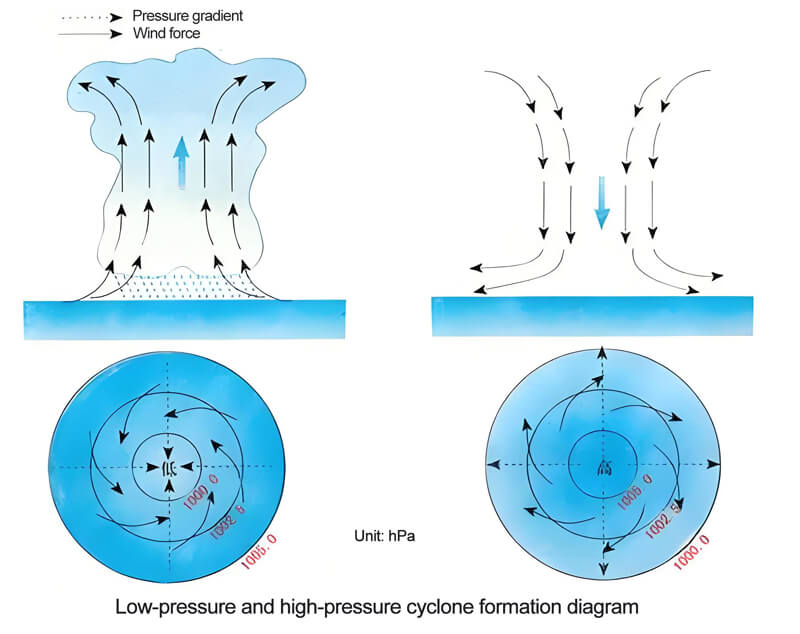
If the air pressure in an area falls rapidly, a “bomb cyclone” (a weather phenomenon in which the air pressure falls by more than 1‰ of standard atmospheric pressure per hour under natural influences, ultimately resulting in a drop in atmospheric pressure of 10% or more) can form, resulting in supercell winds. gale. In just under a day, it killed four people, injured 356, and almost completely paralyzed traffic in Tokyo and elsewhere. Early last year, the blizzard conditions that hit the United States were also linked to the bomb cyclone.
Wind formation
Changes in atmospheric pressure directly affect the movement of air and the direction of flow, and thus the speed and direction of the wind. The process of air flowing from high pressure to low pressure forms wind. The more pressure difference between the two sides, the faster the air flows and the greater the wind speed. In other words, the size of the wind speed is basically proportional to the air pressure gradient.
How does atmospheric pressure affect the body?
For ears
When an airplane takes off or lands, you may feel discomfort in your ears. This is because the sudden change in ambient air pressure increases the pressure difference between inside and outside the ear, which prevents the Eustachian tubes from opening passively, resulting in pain.
For mood
When in a low-pressure environment, the surrounding oxygen concentration decreases, and people will feel difficulty in breathing. This process also causes a change in the mood of the person, which can be characterized as being very irritable and depressed. The psychological changes can lead to increased heart rate, headaches, nausea, etc. This phenomenon is medically known as “hypothermia”. Medically, this phenomenon is called “altitude sickness”.
For sinuses
There is a direct correlation between low air pressure and the onset and duration of migraine headaches. Low air pressure creates a pressure difference between the atmosphere and the sinuses, which can lead to headaches or migraines. The problem is exacerbated when the sinuses are congested or blocked.
For joints
There is a link between air pressure and changes in the temperature of the surrounding environment and the level of knee pain. This could be due to air pressure affecting the viscosity of the fluid that connects the joint capsule, or it could be that it triggers a pain response in the joint’s nerve endings. In either case, some people will experience joint pain when a storm hits.
For blood pressure
Biometeorologists believe that when air pressure drops, so does blood pressure. For some people, this may mean they experience dizziness or blurred vision. Blood vessels respond to sudden changes in humidity, atmospheric pressure, cloud thickness or wind in the surrounding environment in the same way as they do to cold, and weather-related changes in blood pressure are more common in people over the age of 65.
How is atmospheric pressure measured?
1. Mercury Barometer
Mercury barometer is the earliest device used to measure air pressure. The principle of measurement originated from Torricelli’s experiment. Using the principle that the weight of mercury in a glass tube column inverted in a mercury bath balances with the surrounding atmospheric pressure, the height of the mercury column indicates the size of the air pressure. One standard atmospheric pressure is equal to 76 cm of mercury. Modern barometers use other liquids or electronic sensors.
2. Box Barometer
It is made of elastic metal film empty box as a sensing element, the air pressure is converted into empty box elastic displacement, through the lever and transmission mechanism to drive the pointer. When the clockwise direction is deflected, the pointer indicates the amount of change in the increase of air pressure, and vice versa, indicates the amount of change in the decrease of air pressure. It is easy to carry, wide range of pressure measurement and easy to maintain.
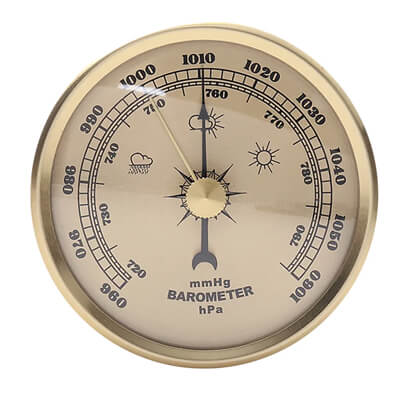
3. Electronic Barometer
An electronic barometer is a portable device that utilizes semiconductor technology and a pressure sensor to measure barometric pressure. During the measurement process, the sensor converts the pressure change into an electrical signal. The electrical signal is processed and the barometric pressure value is displayed on a digital display.
4. Atmospheric Pressure Sensor
The atmospheric pressure sensor working principle is based on a pressure sensitive element. When the air pressure acts on the sensing element, it causes the resistance or capacitance value of the element to change, and different air pressures produce different resistance or capacitance values. Thus the value of air pressure is obtained. It is often equipped with a wind speed sensor, wind direction sensor, solar radiation sensor, rain gauge, etc. to form an automatic weather station.
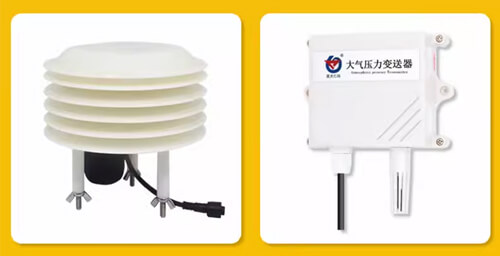
Do you know the difference between barometric pressure and atmospheric pressure?
Barometric pressure and atmospheric pressure are two terms often used interchangeably, both referring to the pressure exerted by the atmosphere on a unit area of the earth’s surface. And they are measured using the same units, such as pascals (Pa), hectopascals (hPa), millibars (mb), inches of mercury (inHg), or millimeters of mercury (mmHg). However, they have subtle differences:
Barometric pressure usually refers to the pressure obtained by measurement with a barometer. A barometer is an instrument that measures air pressure. Barometric pressure is commonly used in weather forecasting and aviation to describe the current air pressure as measured by a barometer.
Atmospheric pressure is the air pressure in the atmosphere at the Earth’s surface. It is a narrower concept compared to the term barometric pressure. It is used to describe pressures in different atmospheric ranges. It is mainly used in weather forecasting, meteorological station and navigational safety.
What will causes low atmospheric pressure?
Increased temperature
In the previous content, we learned that temperature changes affect atmospheric pressure. When the temperature in the air increases, the molecular motion increases, causing the air density to decrease, and the air pressure to decrease. Cold air is denser than warm air and tends to sink more easily, meaning that the molecules in cold air experience higher pressure.
Lowered humidity
In addition to temperature, humidity is also a factor in atmospheric pressure change. In a high humidity environment, water vapor molecules are lighter than air molecules and are more likely to occupy the space above them. Air molecules are squeezed underneath and collisions between molecules are intensified, so the pressure increases. Conversely, when the water vapor content is low, the air pressure is low.
Increased altitude
Atmospheric pressure decreases with altitude. Higher altitudes are less bound by the Earth’s gravitational pull and contain fewer gases, so the pressure is lower. Atmospheric pressure decreases by about 10% for every 1,000 meters of elevation gain. This is because the number of atmospheric molecules decreases with altitude and there are fewer collisions between them. This is why mountaineers tend to feel short of breath and hypoxic at high altitudes, because there are fewer oxygen molecules in the air.
